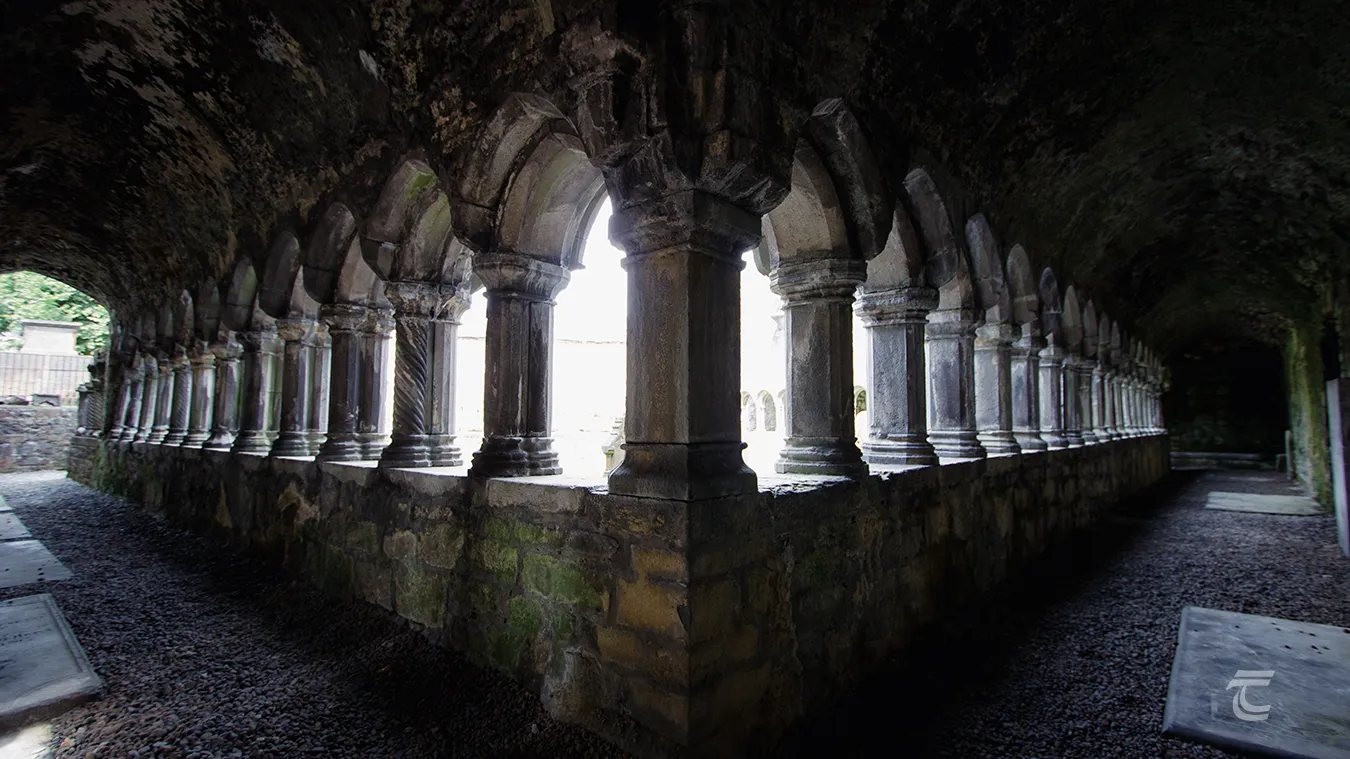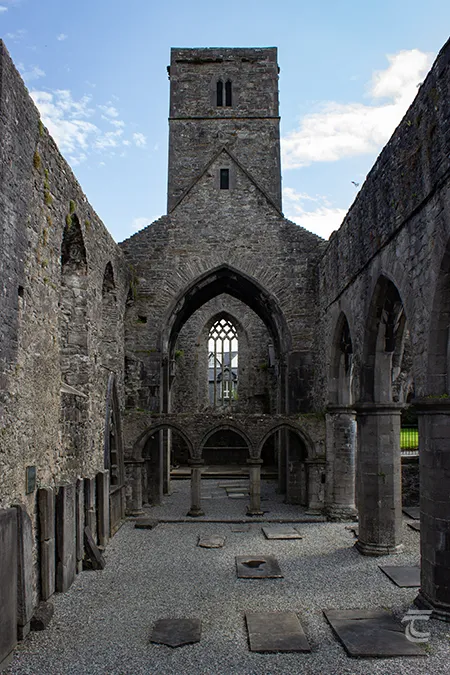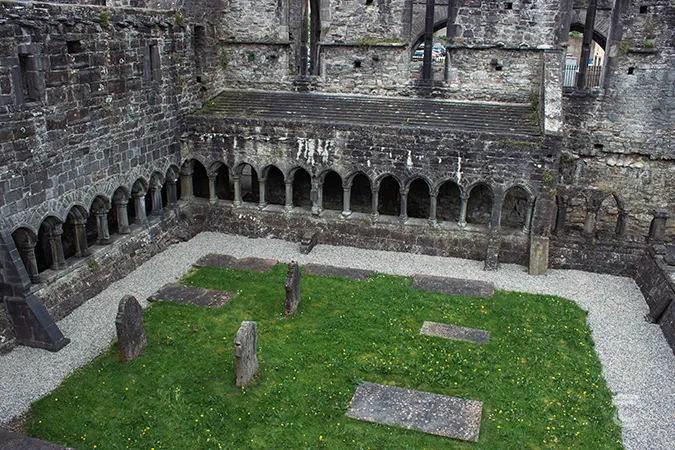Sligo Abbey
Sligo Abbey – a misnomer, since it is in fact a priory – was founded in 1252 for the Dominican Order by Maurice FitzGerald. It was said that he wished to house a community of monks to devote prayers for the soul of Richard Marshal, 3rd Earl of Pembroke (d.1234). Throughout his time as Justiciar of Ireland, and after, FitzGerald had been dogged by rumours that he had betrayed and been responsible for Earl Marshal’s death. An oath taken before the king, Henry III, asserting his innocence, did little to allay these rumours.
The Dominicans were known as ‘The Black Friars’ due to their black cloaks – known as a cappa – worn over white habits. The first Irish Dominican foundation had been established in Athenry, Galway in 1241, a decade prior to the foundation at Sligo. As well as providing for the construction of the abbey, FitzGerald also granted the Sligo friars land on the south bank of the river for agricultural purposes, and fishing rights to the river.
The 13th century was a sporadically turbulent time in Ireland’s history, as the Gaelic nobility sought to reclaim territory from the Anglo-Normans. It wasn’t long before war and raids came to Sligo, and in 1257 the town was burned to the ground by the O’Donnells. By the beginning of the 14th century, the near constant unrest led the FitzGeralds to abandon Sligo altogether. Remarkably, despite the upheaval and destruction taking place at its doorstep, Sligo Abbey not only survived, but appears to have suffered little or no damage. Richard de Burgo, Earl of Ulster, took control of Sligo later in the 14th century, restored its castle, and work continued without hindrance in the abbey.
Over the next century, Sligo Abbey grew in prestige and prominence, becoming the choice burial place for many of the elite of the region including the Lords of Bréifne, the O’Rourkes. This rise, however, was disastrously cut short in 1414, when an accidental fire blazed through the compound. The friars’ living quarters and much of the church were destroyed.
For practical information about visiting this site Click Here

The cloister walk of Sligo Abbey • Sligo
The Resurrection and Final Destruction of Sligo Abbey

Looking down the nave of Sligo Abbey • Sligo
Almost as soon as the ruinous fire was extinguished, efforts were made to restore the abbey. An appeal for aid was sent to John XXII, the Pisan antipope, who responded by granting substantial indulgences to all those who helped contribute to the abbey’s restoration. Perhaps motivated by this, the powerful local dynasties of the O’Connors and the O’Rourkes provided much of the financial aid needed. It was during this period of reconstruction and renewal that the magnificent east window and the distinctive central tower were added.
By the middle of the 16th century, a new existential threat emerged against the religious foundations of Ireland: Henry VIII and his vision for the Dissolution of the Monasteries. Sligo Abbey, however, was initially relatively protected from the immediate effects of this process, being deep within Irish-controlled lands.
In 1595, Sir George Bingham – brother to the President of Connacht, Sir Richard Bingham – launched a series of attacks on the O’Donnell-occupied Sligo Castle. Bingham used Sligo Abbey as a barracks for his troops, and had his men pull down and use the beautifully ornate wooden rood-screen to construct a battering ram to attack the castle. The friars of Sligo Abbey seem to have survived this occupation. By 1608, however, only one Dominican Friar, Father O’Duane, is recorded as being resident. He died a year later.
Father O’Duane’s death, fortunately, did not lead to the extinction of Sligo Abbey. Father O’Crean, a local Dominican who had been preaching in Spain, returned to form a new community. He was supported by a new society of elites, including Eleanor Butler, Countess of Desmond, who erected the O’Connor Memorial in the South Wall of the church. This renaissance, however, would prove all too brief. A fleeting period of peace was quickly followed by a generation of violence and bloodshed throughout Ireland.

Looking down the nave of Sligo Abbey • Sligo
In July 1642, in retaliation for the events of the Rebellion of 1641, Sir Frederick Hamilton, commander of the garrison of Manorhamilton, descended on Sligo. He burned the majority of the town, including the abbey. Any friars who remained were butchered by his men, an event immortalised centuries later by W.B. Yeats in his short story, ‘The Curse of the Fires and of the Shadows‘:
“All the monks were kneeling except the abbot who stood upon the altar steps with a great brass crucifix in his hand. ‘Shoot them’. cried Sir Frederick Hamilton, but nobody stirred for all were new converts and feared the candles and the crucifix. For a little while all were silent and then five troopers who were the bodyguards of Sir Frederick Hamilton, lifted their muskets, and shot down five of the friars. The noise and the smoke drove away the mystery of the pale altar lights, and the other troopers took courage and began to strike. In a moment the friars lay about the altar steps, their white habits stained with blood. ‘Set fire to the house’, cried Sir Frederick Hamilton and a trooper carried in a heap of dry straw, and piled it against the western wall, but did not light it, because he was still afraid of the crucifix and of the candles. Seeing this, the five troopers who were Sir Frederick Hamilton’s bodyguards went up to the altar, and taking each a holy candle set the straw ablaze”
This was the death knell for Sligo Abbey, and in 1763 the Dominican Fathers officially abandoned it in favour of a smaller site on Pound Street (now Connolly Street). Where they still have a presence today. It was around this time that a local merchant quarried the friary, and removed much of its stonework to construct fine townhouses nearby.
Despite this disruption and demolition, Sligo Abbey continued to be used as a burial ground up until the middle of the 19th century. The devastating cholera epidemic which swept through the town in the 1830s put immense pressure on the site, with reports that there was barely enough soil to cover the coffins. Fresh earth had to be transported to the burial ground, raising the level of the graveyard. A 14-year-old resident of Sligo town, Charlotte Thornley, wrote in her diary that “the living struggled to bury the dead”, and how Sligo became “a city of the dead”. There has been some speculation that her accounts from this period may have in part inspired her son, Bram Stoker, in the creation of his gothic work of fiction, Dracula.
By the time the Great Famine had reached Sligo, the graveyard was literally overflowing, with reports of coffins visibly jutting from the ground. Under such pressure, a resolution was passed in 1847 that opened a new cemetery for the town, and Sligo Abbey ceased to be used as an active burial ground.
Upper left: the southern and eastern arcades of the cloister • Lower left: ‘Weepers’ on a late-medieval canopied tomb in the friary • Right: a view of the cloister, and 15th century tower
Top: the southern and eastern arcades of the cloister • Middle: a view of the cloister, and 15th century tower • Bottom: ‘Weepers’ on a late-medieval canopied tomb in the friary
Explore more sites on the Wild Atlantic Way





